We take the little strips used in blood testing for granted, but you’d be surprised at the science involved in each one.
 Having a blood test meter that you can just pick up and put in your pocket is still one of today’s modern miracles in terms of diabetes self-care. In an article written in 2009 for the Journal of Diabetes Science and Technology Barry Ginsberg (M.D., Ph.D) started his study by saying, “Glucose monitoring has become an integral part of diabetes care but has some limitations in accuracy. Accuracy may be limited due to strip manufacturing variances, strip storage, and aging. They may also be due to limitations on the environment such as temperature or altitude or to patient factors such as improper coding, incorrect hand washing, altered haematocrit*, or naturally occurring interfering substances. Finally, external interfering substances may contribute errors to the system evaluation of blood glucose.”
Having a blood test meter that you can just pick up and put in your pocket is still one of today’s modern miracles in terms of diabetes self-care. In an article written in 2009 for the Journal of Diabetes Science and Technology Barry Ginsberg (M.D., Ph.D) started his study by saying, “Glucose monitoring has become an integral part of diabetes care but has some limitations in accuracy. Accuracy may be limited due to strip manufacturing variances, strip storage, and aging. They may also be due to limitations on the environment such as temperature or altitude or to patient factors such as improper coding, incorrect hand washing, altered haematocrit*, or naturally occurring interfering substances. Finally, external interfering substances may contribute errors to the system evaluation of blood glucose.”
So your strips matter, you meter matters and your blood testing technique matters too. To a great extent you can be assured that most blood test meters test just fine – this article is not about to state otherwise, it’s purpose is to reveal exactly what goes into making a blood test accurate, starting with the strips themselves but in conjunction with its meter.
The Science
A study published in the Journal of Diabetes Science and Technology (Volume 6, Issue 5, September 2012)* looked at the accuracy of blood test systems. It assessed 43 blood glucose monitoring systems for the SMBG (in other words the self-monitoring of blood glucose with blood test meters).
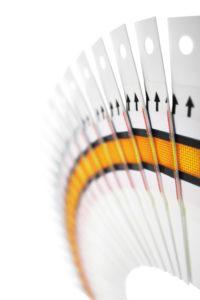 Clearly the accuracy of systems for self-monitoring of blood glucose is important, reliable measurement results being a prerequisite for therapeutic decisions.
Clearly the accuracy of systems for self-monitoring of blood glucose is important, reliable measurement results being a prerequisite for therapeutic decisions.
From the 34 systems completely assessed, the study concluded that seven systems did not fulfill the minimal accuracy requirements of the ISO standard and that the European CE mark does not guarantee that all blood glucose systems provide accuracy according to the standard. The clinical benefits of SMBG in diabetes patients are widely accepted, and today, SMBG is recommended for all people with diabetes, particularly for adjustment of insulin in patients with multiple daily injections.
A multitude of SMBG systems is available on the market. An increasing number of new systems have been introduced. Physicians and patients are looking for guidance to choose between systems with different price ranges, including well-established systems as well as completely new systems
In Europe, manufacturers of BG systems have to provide evidence of conformity with the ISO standard in order to get the Conformité Européenne (CE) mark for their products. However, an evaluation study published in 2010 showed that more than 40% of the systems investigated did not fulfill the minimum accuracy criteria of the ISO standard. The categorization of BG systems into different quality classes and for different patient groups with specific needs for accuracy is frequently discussed.
Several previous studies reported that some test strips, especially those with glucose oxidase enzyme reaction, are sensitive to oxygen and that high oxygen concentrations may lead to system results lower than the true value – it’s one of the reason your test strips come in light-proof pots and you nee dto keep them in the pots that they come in as they often have silica walls to reduce water contenf of the air and keep the strips stable and therefore keep the readings accurate.
In summary, the report stated that 34 out of 43 BG systems were completely assessed, and 27 (79.4%) of the 34 systems fulfill the minimal accuracy requirements of the standard DIN EN ISO 15197:2003. Only 18 (52.9%) of 34 systems fulfilled the minimal accuracy requirements if tighter criteria of the current draft revision of ISO 15197 are considered.
*System Accuracy Evaluation of 43 Blood Glucose Monitoring Systems for Self-Monitoring of Blood Glucose according to DIN EN ISO 15197, Guido Freckmann, M.D., Christina Schmid, Ph.D., Annette Baumstark, Ph.D., Stefan Pleus, M.S.,Manuela Link, M.E., and Cornelia Haug, M.D. This study was funded by a grant from Roche Diagnostics GmbH, Mannheim, Germany.
INSIDE SOME OF THE AVAILABLE BLOOD TEST STRIPS
Smart practice

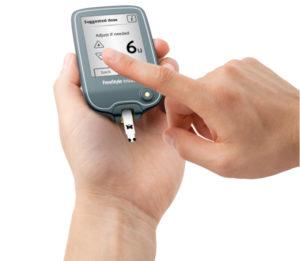 The Verio IQ blood test meter needs no code and takes only 5 seconds to test with a glucose range of 1.1 mmol/L – 33.3 mmol/L, an haematocrit range of 20% – 60% within a temperature testing range of 6-44°C and humidity range of 10% – 90% (non-condensing). SmartScan Technology scans the reaction chamber 500 times over a three-phase application of voltage. The reversed polarity of the third phase enables a comparison to be made that accounts for variations in haematocrit and corrects for common interfering substances that are present in a blood sample. The images show how this works…. And note that these sensors even use a tiny bit of gold in them. Class!
The Verio IQ blood test meter needs no code and takes only 5 seconds to test with a glucose range of 1.1 mmol/L – 33.3 mmol/L, an haematocrit range of 20% – 60% within a temperature testing range of 6-44°C and humidity range of 10% – 90% (non-condensing). SmartScan Technology scans the reaction chamber 500 times over a three-phase application of voltage. The reversed polarity of the third phase enables a comparison to be made that accounts for variations in haematocrit and corrects for common interfering substances that are present in a blood sample. The images show how this works…. And note that these sensors even use a tiny bit of gold in them. Class!
Wik-ed!
It turns out that the way a sensor pulls your blood inside it is called ‘wicking’ and several meters use groovy techniques and technology to get the smallest sample to do a test on. Among them are the Freestyle meters from Abbott which feature ZipWik technology, ensuring fast, effective blood uptake as well as blood glucose test result accuracy.
Zero failure
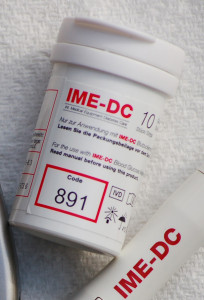 The IME-DC blood test meter achieves the aims of being extremely easy to use, and in fact features just one button. The meter includes SIP-IN Technology, which makes applying blood to the strip fail-safe, so there are no failed tests due to not enough blood being put on the strip. Blood tests also operate on a very small (2µl) blood sample, taking 10 seconds before being shown on a large, easy-to-read LCD screen. The test range measured is 1.1 – 33.3 mmol / L with coding done via a chip. The meter features uses a series automatic system checks including one for temperature correction.
The IME-DC blood test meter achieves the aims of being extremely easy to use, and in fact features just one button. The meter includes SIP-IN Technology, which makes applying blood to the strip fail-safe, so there are no failed tests due to not enough blood being put on the strip. Blood tests also operate on a very small (2µl) blood sample, taking 10 seconds before being shown on a large, easy-to-read LCD screen. The test range measured is 1.1 – 33.3 mmol / L with coding done via a chip. The meter features uses a series automatic system checks including one for temperature correction.
Preventing interference
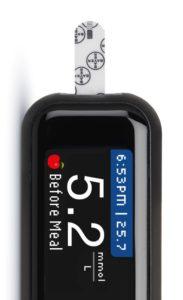 Bayer’s Contour Next test strips use FAD-GDH technology and have a built-in correction electrode to protect against interference from common substances. Tested with more than 30 common interfering substances (such as paracetamol, Vitamin C, maltose, galactose, oxygen) and shown to demonstrate consistent accuracy. They have also tested for uric acid which can be elevated in the blood due to as far-ranging things as obesity, uncontrolled hypertension, insulin resistance, gout, excessive exercise and pre-eclampsia. Uric acid levels can affect blood glucose meter accuracy but Bayer’s Contour Next meters automatically correct for uric acid up to a concentration of 3.5mmol/L. They also have a built-in correction electrode that automatically measures and corrects for haematocrit in the range 0-70%, which reduces the risk of error.
Bayer’s Contour Next test strips use FAD-GDH technology and have a built-in correction electrode to protect against interference from common substances. Tested with more than 30 common interfering substances (such as paracetamol, Vitamin C, maltose, galactose, oxygen) and shown to demonstrate consistent accuracy. They have also tested for uric acid which can be elevated in the blood due to as far-ranging things as obesity, uncontrolled hypertension, insulin resistance, gout, excessive exercise and pre-eclampsia. Uric acid levels can affect blood glucose meter accuracy but Bayer’s Contour Next meters automatically correct for uric acid up to a concentration of 3.5mmol/L. They also have a built-in correction electrode that automatically measures and corrects for haematocrit in the range 0-70%, which reduces the risk of error.
Making Waves
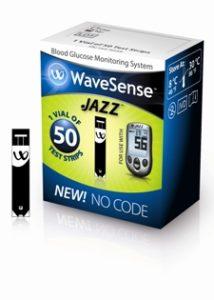 WaveSense is an alternative technology in blood glucose meter testing. There is no coding involved and one version of the meter is wireless. WaveSense is the name of the brand, but the meters are called Jazz and Jazz Wireless. The patented technology used in the meters is called WaveSense Dynamic Electrochemistry. What it is designed to do is address how everyday events and conditions can cause a meter to distort the result, so environmental variations (such as temperature, altitude or humidity) that can affect the reading are minimized. The meters send electrical signals to the test strip to identify common sources of error then uses advanced algorithms to detect and correct these errors to provide the most accurate results. They come with Zero-Click blood glucose results management software.
WaveSense is an alternative technology in blood glucose meter testing. There is no coding involved and one version of the meter is wireless. WaveSense is the name of the brand, but the meters are called Jazz and Jazz Wireless. The patented technology used in the meters is called WaveSense Dynamic Electrochemistry. What it is designed to do is address how everyday events and conditions can cause a meter to distort the result, so environmental variations (such as temperature, altitude or humidity) that can affect the reading are minimized. The meters send electrical signals to the test strip to identify common sources of error then uses advanced algorithms to detect and correct these errors to provide the most accurate results. They come with Zero-Click blood glucose results management software.
Alternate options
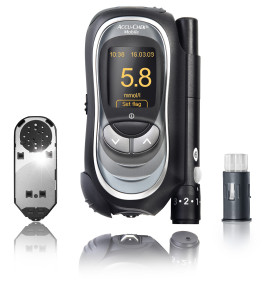 The Accu-Chek range of blood test meters includes a selection that feature blood test strips (sensors) but a few years ago they added in a new option, the Mobile blood test system. This features a cassette that has a long piece of reagent strip (see the meter, far right, and the cassette, right). This novel idea meant that each new cassette could do up to 50 tests before a new one needed to be installed. With a detachable finger-pricker attached to the side, it meant that a test could be completed all in one go. The cassette strip technology is great for those who find fiddling about with a new sensor each time you need to do a test (so those with small or less dexterous hands), or people who are pressed for time. It saves on chucking away test strips too (they do end up everywhere don’t they?).
The Accu-Chek range of blood test meters includes a selection that feature blood test strips (sensors) but a few years ago they added in a new option, the Mobile blood test system. This features a cassette that has a long piece of reagent strip (see the meter, far right, and the cassette, right). This novel idea meant that each new cassette could do up to 50 tests before a new one needed to be installed. With a detachable finger-pricker attached to the side, it meant that a test could be completed all in one go. The cassette strip technology is great for those who find fiddling about with a new sensor each time you need to do a test (so those with small or less dexterous hands), or people who are pressed for time. It saves on chucking away test strips too (they do end up everywhere don’t they?).
This news item first appeared in our free-to-receive online magazine. Go to the home page of this website to sign up – we just need your email address.



